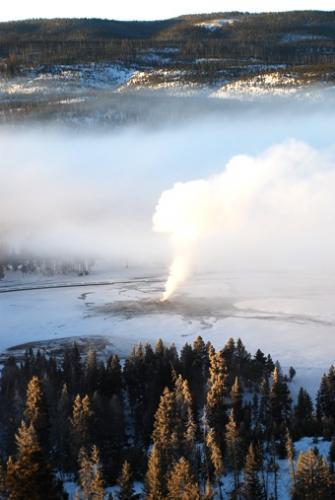Wyoming's governor believes 540 snowmobiles a day could travel through Yellowstone National Park in winter without adversely impacting wildlife, air quality, or the park's soundscape.
Gov. Matt Mead made that point in the state's official comments to park officials, who are working on yet another environmental impact statement intended to come up with a feasible and legally defensible winter-use plan for Yellowstone.
"The daily limits listed in the proposed rule for snowmobile use is too low. The best available information for air quality, soundscape, and wildlife supports a level in the range of 540 snowmobiles per day," wrote the governor. "At that daily allocation level the impact to resources is recorded as minimal within the Draft Yellowstone Winter Use Plan and DEIS."
The park's currently preferred alternative, he said, would reduce by nearly 6,000 the number of snowmobiles entering the park over the course of the winter. Such a reduction would have a direct impact on the regional economy, Gov. Mead wrote.
"Yellowstone winter use is closely tied to businesses involved with recreation, hotels, restaurants, etc. Local communities are built around a seasonal economy, and the park is a large piece of that seasonal economy," he noted.
For more than a decade the debate over how winter in Yellowstone should be enjoyed has dragged on. The Park Service has gone back and forth with the political winds, calling back in 2000 for recreational snowmobile use to be phased out completely only to see the Bush administration drop that decision in favor of continued snowmobile use.
Legal battles waged by those who want continued snowmobile use and those who believe Yellowstone would be healthier without snowmobiles have prolonged the debate and led to a fistful of environmental studies -- environmental assessments as well as more complex and detailed environmental impact statements.
Under the park's currently preferred alternative, up to 330 snowmobiles and 80 snowcoaches would be allowed daily into the park for 45 days of the 90-day winter season. However, the Park Service's own science has pointed to 250 as the daily threshhold of snowmobiles over which the park's resources would be adversely impacted.
There are seven alternatives in the DEIS. In addition to the park's preferred option, which calls for a sliding scale of sorts that would determine daily snowmobile and snowcoach limits, one option calls for not allowing any motorized use, another calls for phasing out snowmobiles in favor of snowcoaches, and one proposes allowing up to 720 snowmobiles and 78 snowcoaches per day.
In his letter to the park, Gov. Mead believes the park's preferred alternative would prevent many visitors from enjoying Yellowstone in winter.
"Protection of resources does not have to come at the expense of access; we can have both -- healthy resources and open access," the governor stressed. "I reiterate what I wrote you in July -- we can balance protection of the park’s resources and snowmobile access, and I am committed to working with you and others to that end."
Gov. Mead also urged the park to allow non-commercial snowmobile trips in the park.
"The requirement that 100% of snowmobile entries into Yellowstone be commercially guided is extreme and unreasonable. Responsible non-commercial use of Yellowstone can be accomplished," he maintained. "It can be accomplished through a well-designed non-commercial guide system that includes an educational component with Yellowstone-specific elements to help visitors safely and responsibly visit the park. Non-commercial access to Yellowstone is important to the State of Wyoming, its communities, citizens, and visitors."




Comments
You may not be able to SEE any adverse effects on the animals; however, animal stress levels increase during the winter due to scarce resources and cold weather as it is. Bison are creatures of habit and will travel the paths they know to get to the resources they know are there. Sure, if you don't try to interact with them, they'll just walk by you, but the noise that snowmobiles make causes an increased stress reaction the "fight or flight" portion of their brains are constantly active around you. If such reactions become common and sustained, they are more prone to disease (due to a lower immune system) and have fewer offspring which suffer just as human infants whose mothers were stressed during the gestation period suffer. They are restless, cholic and may suffer from similar immuno deficiencies.